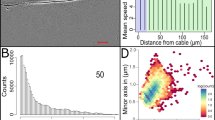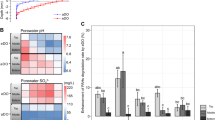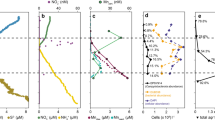Abstract
Cable bacteria are filamentous members of the Desulfobulbaceae family that oxidize sulfide with oxygen or nitrate by transferring electrons over centimeter distances in sediments. Recent studies show that freshwater sediments can support populations of cable bacteria at densities comparable to those found in marine environments. This is surprising since sulfide availability is presumably low in freshwater sediments due to sulfate limitation of sulfate reduction. Here we show that cable bacteria stimulate sulfate reduction in freshwater sediment through promotion of sulfate availability. Comparing experimental freshwater sediments with and without active cable bacteria, we observed a three- to tenfold increase in sulfate concentrations and a 4.5-fold increase in sulfate reduction rates when cable bacteria were present, while abundance and community composition of sulfate-reducing microorganisms (SRM) were unaffected. Correlation and ANCOVA analysis supported the hypothesis that the stimulation of sulfate reduction activity was due to relieve of the kinetic limitations of the SRM community through the elevated sulfate concentrations in sediments with cable bacteria activity. The elevated sulfate concentration was caused by cable bacteria-driven sulfide oxidation, by sulfate production from an indigenous sulfide pool, likely through cable bacteria-mediated dissolution and oxidation of iron sulfides, and by enhanced retention of sulfate, triggered by an electric field generated by the cable bacteria. Cable bacteria in freshwater sediments may thus be an integral component of a cryptic sulfur cycle and provide a mechanism for recycling of the scarce resource sulfate, stimulating sulfate reduction. It is possible that this stimulation has implication for methanogenesis and greenhouse gas emissions.
Similar content being viewed by others
Log in or create a free account to read this content
Gain free access to this article, as well as selected content from this journal and more on nature.com
or
References
Holmer M, Storkholm P. Sulphate reduction and sulphur cycling in lake sediments: a review. Freshw Biol. 2001;46:431–51.
Soetaert K, Herman PMJ, Middelburg JJ. A model of early diagenetic processes from the shelf to abyssal depths. Geochim Cosmochim Acta. 1996;60:1019–40.
Capone DG, Kiene RP. Comparison of microbial dynamics in marine and freshwater sediments: contrasts in anaerobic carbon catabolism1. Limnol Oceanogr. 1988;33:725–49.
Canavan RW, Slomp CP, Jourabchi P, Van Cappellen P, Laverman AM, van den Berg GA. Organic matter mineralization in sediment of a coastal freshwater lake and response to salinization. Geochim Cosmochim Acta. 2006;70:2836–55.
Jørgensen BB. Comparison of methods for the quantification of bacterial sulfate reduction in coastal marine-sediments. 1. Measurement with radiotracer techniques. Geomicrobiol J. 1978;1:11–27.
Holmkvist L, Ferdelman TG, Jorgensen BB. A cryptic sulfur cycle driven by iron in the methane zone of marine sediment (Aarhus Bay, Denmark). Geochim Cosmochim Acta. 2011;75:3581–99.
Jørgensen BB, Findlay AJ, Pellerin A. The biogeochemical sulfur cycle of marine sediments. Front Microbiol. 2019;10:1–27.
Jørgensen BB, Parkes RJ. Role of sulfate reduction and methane production by organic carbon degradation in eutrophic fjord sediments (Limfjorden, Denmark). Limnol Oceanogr. 2010;55:1338–52.
Bak F, Pfennig N. Microbial sulfate reduction in littoral sediment of Lake Constance. FEMS Microbiol Lett. 1991;85:31–42.
Urban NR, Brezonik PL, Baker LA, Sherman LA. Sulfate reduction and diffusion in sediments of Little Rock Lake, Wisconsin. Limnol Oceanogr. 1994;39:797–815.
Roden EE, Tuttle JH. Inorganic sulfur turnover in oligohaline estuarine sediments. Biogeochemistry. 1993;22:81–105.
Pellerin A, Bui TH, Rough M, Mucci A, Canfield DE, Wing BA. Mass-dependent sulfur isotope fractionation during reoxidative sulfur cycling: a case study from Mangrove Lake, Bermuda. Geochim Cosmochim Acta. 2015;149:152–64.
Canfield DE. Reactive iron in marine-sediments. Geochim Cosmochim Acta. 1989;53:619–32.
Elsgaard L, Jørgensen BB. Anoxie transformations of radiolabeled hydrogen sulfide in marine and freshwater sediments. Geochim Cosmochim Acta. 1992;56:2425–35.
King GM. Effects of added manganic and ferric oxides on sulfate reduction and sulfide oxidation in intertidal sediments. FEMS Microbiol Ecol. 1990;6:131–8.
Pester M, Knorr K-H, Friedrich MW, Wagner M, Loy A. Sulfate-reducing microorganisms in wetlands—fameless actors in carbon cycling and climate change. Front Microbiol. 2012;3:1–19.
Malkin SY, Rao AMF, Seitaj D, Vasquez-Cardenas D, Zetsche E-M, Hidalgo-Martinez S, et al. Natural occurrence of microbial sulphur oxidation by long-range electron transport in the seafloor. ISME J. 2014;8:175–9.
Pfeffer C, Larsen S, Song J, Dong MD, Besenbacher F, Meyer RL, et al. Filamentous bacteria transport electrons over centimetre distances. Nature. 2012;491:218–21.
Marzocchi U, Trojan D, Larsen S, Meyer RL, N.P R, Schramm A, et al. Electric coupling between distant nitrate reduction and sulfide oxidation in marine sediment. ISME J. 2014;8:1682–90.
Nielsen LP, Risgaard-Petersen N, Fossing H, Christensen PB, Sayama M. Electric currents couple spatially separated biogeochemical processes in marine sediment. Nature. 2010;463:1071–4.
Burdorf LDW, Tramper A, Seitaj D, Meire L, Hidalgo-Martinez S, Zetsche EM, et al. Long-distance electron transport occurs globally in marine sediments. Biogeosciences. 2017;14:683–701.
Marzocchi U, Bonaglia S, van de Velde S, Hall POJ, Schramm A, Risgaard-Petersen N, et al. Transient bottom water oxygenation creates a niche for cable bacteria in long-term anoxic sediments of the Eastern Gotland Basin. Environ Microbiol. 2018;20:3031–41.
Muller H, Bosch J, Griebler C, Damgaard LR, Nielsen LP, Lueders T, et al. Long-distance electron transfer by cable bacteria in aquifer sediments. ISME J. 2016:2010–9.
Risgaard-Petersen N, Kristiansen M, Frederiksen RB, Dittmer AL, Bjerg JT, Trojan D, et al. Cable Bacteria in freshwater sediments. Appl Environ Microbiol. 2015;81:6003–11.
Meysman FJR, Risgaard-Petersen N, Malkin SY, Nielsen LP. The geochemical fingerprint of microbial long-distance electron transport in the seafloor. Geochim Cosmochim Acta. 2015;152:122–42.
Risgaard-Petersen N, Revil A, Meister P, Nielsen LP. Sulfur, iron-, and calcium cycling associated with natural electric currents running through marine sediment. Geochim Cosmochim Acta. 2012;92:1–13.
Kjeldsen KU, Schreiber L, Thorup CA, Boesen T, Bjerg JT, Yang T, et al. On the evolution and physiology of cable bacteria. Proc Natl Acad Sci USA. 2019;116:19116–25.
Rao AMF, Malkin SY, Hidalgo-Martinez S, Meysman FJR. The impact of electrogenic sulfide oxidation on elemental cycling and solute fluxes in coastal sediment. Geochim Cosmochim Acta. 2016;172:265–86.
Seitaj D, Schauer R, Sulu-Gambari F, Hidalgo-Martinez S, Malkin SY, Burdorf LDW, et al. Cable bacteria generate a firewall against euxinia in seasonally hypoxic basins. Proc Natl Acad Sci USA. 2015;112:13278–83.
Sulu-Gambari F, Seitaj D, Meysman FJR, Schauer R, Polerecky L, Slomp CP. Cablebacteria control iron–phosphorus dynamics in sediments of a coastal hypoxic basin. Environ Sci Technol. 2016;50:1227–33.
Damgaard LR, Risgaard-Petersen N, Nielsen LP. Electric potential microelectrode for studies of electro-biogeophysics. J Geophys Res. 2014;119:2014JG002665.
Risgaard-Petersen N, Damgaard LR, Revil A, Nielsen LP. Mapping electron sources and sinks in a marine biogeobattery. J Geophys Res (Biogeosci). 2014;119:1475–86.
Bockris JOM, Reddy AKN. Modern electrochemistry—ionics. 2nd ed. New York: Plenum Press; 1998. p. 769.
Ingvorsen K, Jørgensen BB. Kinetics of sulfate uptake by freshwater and marine species of Desulfovibrio. Arch Microbiol. 1984;139:61–6.
Pallud C, Van Cappellen P. Kinetics of microbial sulfate reduction in estuarine sediments. Geochim Cosmochim Acta. 2006;70:1148–62.
van de Velde S, Lesven L, Burdorf LDW, Hidalgo-Martinez S, Geelhoed JS, Van Rijswijk P, et al. The impact of electrogenic sulfur oxidation on the biogeochemistry of coastal sediments: a field study. Geochim Cosmochim Acta. 2016;194:211–32.
Müller AL, Kjeldsen KU, Rattei T, Pester M, Loy A. Phylogenetic and environmental diversity of DsrAB-type dissimilatory (bi)sulfite reductases. ISME J. 2014;9:1152.
van de Velde S, Meysman FJR. The influence of bioturbation on iron and sulphur cycling in marine sediments: a model analysis. Aquat Geochem. 2016;22:469–504.
Risgaard-Petersen N. Coupled nitrification-denitrification in autotrophic and heterotrophic estuarine sediments: on the influence of benthic microalgae. Limnol Oceanogr. 2003;48:93–105.
Risgaard-Petersen N, Langezaal AM, Ingvardsen S, Schmid MC, Jetten MSM, Op den Camp HJM, et al. Evidence for complete denitrification in a benthic foraminifer. Nature. 2006;443:93–6.
Risgaard-Petersen N, Meyer RL, Revsbech NP. Denitrification and anaerobic ammonium oxidation in sediments: effects of microphytobenthos and NO3-. Aquat Microb Ecol. 2005;40:67–76.
Jensen K, Sloth NP, Risgaard-Petersen N, Rysgaard S, Revsbech NP. Estimation of nitrification and denitrification from microprofiles of oxygen and nitrate in model sediment systems. Appl Environ Microb. 1994;60:2094–100.
Burdorf LDW, Malkin SY, Bjerg JT, van Rijswijk P, Criens F, Tramper A, et al. The effect of oxygen availability on long-distance electron transport in marine sediments. Limnol Oceanogr. 2018;63:1799–816.
Revsbech NP. An oxygen microsensor with a guard cathode. Limnol Oceanogr. 1989;34:474–8.
Schauer R, Risgaard-Petersen N, Kjeldsen KU, Bjerg JJT, Jørgensen BB, Schramm A, et al. Succession of cable bacteria and electric currents in marine sediment. ISME J. 2014;8:1314–22.
Lücker S, Steger D, Kjeldsen KU, MacGregor BJ, Wagner M, Loy A. Improved 16S rRNA-targeted probe set for analysis of sulfate-reducing bacteria by fluorescence in situ hybridization. J Microbiol Methods. 2007;69:523–8.
Jeroschewski P, Steuckart C, Kuhl M. An amperometric microsensor for the determination of H2S in aquatic environments. Anal Chem. 1996;68:4351–7.
Revsbech NP, Jørgensen BB. Microelectrodes—their use in microbial ecology. Adv Microb Ecol. 1986;9:293–352.
Cline JD. Spectrophotometric determination of hydrogen sulfide in natural waters. Limnol Oceanogr. 1969;14:454–8.
Røy H, Weber HS, Tarpgaard IH, Ferdelman TG, Jørgensen BB. Determination of dissimilatory sulfate reduction rates in marine sediment via radioactive 35S tracer. Limnol Oceanogr Methods. 2014;12:196–211.
Moeslund L, Thamdrup B, Barker Jørgensen B. Sulfur and iron cycling in a coastal sediment: Radiotracer studies and seasonal dynamics. Biogeochemistry. 1994;27:129–52.
Xiao K-Q, Beulig F, Røy H, Jørgensen BB, Risgaard-Petersen N. Methylotrophic methanogenesis fuels cryptic methane cycling in marine surface sediment. Limnol Oceanogr. 2018;63:1519–27.
Kallmeyer J, Ferdelman TG, Weber A, Fossing H, Jorgensen BB. A cold chromium distillation procedure for radiolabeled sulfide applied to sulfate reduction measurements. Limnol Oceanogr Methods. 2004;2:171–80.
Tarpgaard IH, Røy H, Jørgensen BB. Concurrent low- and high-affinity sulfate reduction kinetics in marine sediment. Geochim Cosmochim Acta. 2011;75:2997–3010.
Kamp A, Petro C, Roy H, Nielsen S, Carvalho P, Stief P, et al. Intracellular nitrate in sediments of an oxygen-deficient marine basin is linked to pelagic diatoms. FEMS Microbiol Ecol. 2018;94:1–12.
Jochum LM, Chen X, Lever MA, Loy A, Jørgensen BB, Schramm A, et al. Depth distribution and assembly of sulfate-reducing microbial communities in marine sediments of Aarhus Bay. Appl Environ Microb. 2017;83:e01547–17.
Chen X, Andersen TJ, Morono Y, Inagaki F, Jørgensen BB, Lever MA. Bioturbation as a key driver behind the dominance of Bacteria over Archaea in near-surface sediment. Sci Rep. 2017;7:2400.
Lever MA, Rouxel O, Alt JC, Shimizu N, Ono S, Coggon RM, et al. Evidence for microbial carbon and sulfur cycling in deeply buried ridge flank basalt. Science 2013;339:1305–8.
Pelikan C, Herbold CW, Hausmann B, Müller AL, Pester M, Loy A. Diversity analysis of sulfite- and sulfate-reducing microorganisms by multiplex dsrA and dsrB amplicon sequencing using new primers and mock community-optimized bioinformatics. Environ Microbiol. 2016;18:2994–3009.
R-Core-Team. R: a language and environment for statistical computing. Vienna, Austria: R Foundation for Statistical Computing; 2017. https://www.R-project.org/.
Lenth RV, Least-square means: the R Package lsmeans. 2016;69:332016.
Boudreau BC. Diagenetic models and their implementation. Berlin: Springer; 1997.
Ullman WJ, Aller RC. Diffusion-coefficients in nearshore marine-sediments. Limnol Oceanogr. 1982;27:552–6.
Soetaert K, Petzoldt T, Meysman F. marelac: tools for aquatic sciences. R package version 2.1. 2010. https://CRAN.R-project.org/package=marelac.
Berg P, Risgaard-Petersen N, Rysgaard S. Interpretation of measured concentration profiles in sediment pore water. Limnol Oceanogr. 1998;43:1500–10.
Callahan BJ, McMurdie PJ, Rosen MJ, Han AW, Johnson AJA, Holmes SP. DADA2: high-resolution sample inference from Illumina amplicon data. Nat Methods. 2016;13:581.
Marshall IPG, Ren G, Jaussi M, Lomstein BA, Jørgensen BB, Røy H, et al. Environmental filtering determines family-level structure of sulfate-reducing microbial communities in subsurface marine sediments. ISME J. 2019;13:1920–32.
Trojan D, Schreiber L, Bjerg JT, Bøggild A, Yang T, Kjeldsen KU, et al. A taxonomic framework for cable bacteria and proposal of the candidate genera Electrothrix and Electronema. Syst Appl Microbiol. 2016;39:297–306.
McMurdie PJ, Holmes S. Phyloseq: an R package for reproducible interactive analysis and graphics of microbiome census data. Plos ONE. 2013;8:e61217.
Oksanen J, Blanchet FG, Michael Friendly, Kindt R, Legendre P, McGlinn D, et al. Vegan: Community Ecology R package version 25-4. 2019. https://cran.r-project.org.
Clarke KR. Non-parametric multivariate analyses of changes in community structure. Aust J Ecol. 1993;18:117–43.
Robinson MD, McCarthy DJ, Smyth GK. edgeR: a bioconductor package for differential expression analysis of digital gene expression data. Bioinformatics. 2009;26:139–40.
Wörner S, Pester M. The active sulfate-reducing microbial community in littoral sediment of oligotrophic Lake Constance. Front Microbiol. 2019;10:247.
Froelich PN, Klinkhammer GP, Bender ML, Luedtke NA, Heath GR, Cullen D, et al. Early Oxidation of organic-matter in pelagic sediments of the eastern equatorial atlantic—suboxic diagenesis. Geochim Cosmochim Acta. 1979;43:1075–90.
Jørgensen BB. The sulfur cycle of freshwater sediments: role of thiosulfate. Limnol Oceanogr. 1990;35:1329–42.
Acknowledgements
The authors thank Lars Borregaard Pedersen, Karina Bomholt, Britta Poulsen, Susanne Nielsen, Jeanette Johansen, and Lykke Beinta Bjærge Bamdali for their skillful assistance in the lab. Ian Marshall is thanked for assistance with the bioinformatics. Three anonymous reviewers are acknowledge for their constructive criticism. This study was supported by the Danish National Research Foundation [Agreement nos. DNRF104 and DNRF136] and by a Marie Sklodowska-Curie Individual Fellowship [grant agreement No 656385] awarded to Ugo Marzocchi.
Author information
Authors and Affiliations
Corresponding author
Ethics declarations
Conflict of interest
The authors declare that they have no conflict of interest.
Additional information
Publisher’s note Springer Nature remains neutral with regard to jurisdictional claims in published maps and institutional affiliations.
Supplementary information
Rights and permissions
About this article
Cite this article
Sandfeld, T., Marzocchi, U., Petro, C. et al. Electrogenic sulfide oxidation mediated by cable bacteria stimulates sulfate reduction in freshwater sediments. ISME J 14, 1233–1246 (2020). https://doi.org/10.1038/s41396-020-0607-5
Received:
Revised:
Accepted:
Published:
Issue date:
DOI: https://doi.org/10.1038/s41396-020-0607-5
This article is cited by
-
A framework for understanding collective microbiome metabolism
Nature Microbiology (2024)
-
Microbial strategies driving low concentration substrate degradation for sustainable remediation solutions
npj Clean Water (2024)
-
Anwendungen der Kabelbakterien in der Umwelt- und Biotechnologie
BIOspektrum (2024)
-
Cable bacteria with electric connection to oxygen attract flocks of diverse bacteria
Nature Communications (2023)
-
Dissimilatory nitrate reduction by a freshwater cable bacterium
The ISME Journal (2022)



